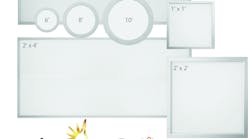LED technology saw broad use in the recently-concluded London Olympic Games for entertainment and functional lighting. In both the Opening and Closing Ceremonies, color-changing LED fixtures created patterns, text and animated effects in the seating areas of the stadium that were visible on TV. More than 70,000 LED modules, each containing nine LEDs, were positioned next to the spectator seats.
GE Lighting was a major sponsor of the Olympics and supplied both LED and legacy lighting into a variety of applications at the Olympics. Within the main Olympic Park, GE supplied 25,000 Tetra PowerMAX LED modules and Tetra LED drivers for night-time orientation lighting.
Philips Lighting was also involved in supplying the LED lighting for pedestrian thoroughfares within the Olympic Park area that were powered by wind turbines.
Moving to testing and characterization of LED lights, the Lighting Research Center has published a new ASSIST Recommends document that defines acceptable parameters related to flicker. Flicker remains a controversial aspect of LED lighting as it can cause a number of maladies in humans including seizure. Most solid-state lighting vendors believe they have solved the flicker problem. The LRC research defines light-source parameters such as frequency and modulation depth and how these parameters relate to human reaction to flicker and stroboscopic effects.
The US Department of Energy also released new testing data in its Caliper program, this time focused on LED-based retrofit lamps for AR111 directional applications. While the AR111 is a niche application, it's still disappointing to see that the solid-state lighting products didn't perform as well as other types of LED retrofit lamps that the DOE has tested recently.
Our final story this week covers forward looking technology from Albeo Technologies that came to light with the company being awarded US Patent 8,056,659. The patent covers the direct integration of bare LED die into a luminaire with some of the surfaces of the luminaire serving as a de facto printed circuit board. Albeo says that the technology can significantly reduce cost by eliminating the package in which an LED is encapsulated and the circuit board upon which it is mounted. Albeo plans to target ceiling troffers. Many obstacles remain, however, as the company will have to find a way to automate a pick-and-place process to install LEDs in a fixture and another process to deposit phosphor on the installed LED, possibly using an inkjet deposition system. The company hopes to get a product to market in 2013.




